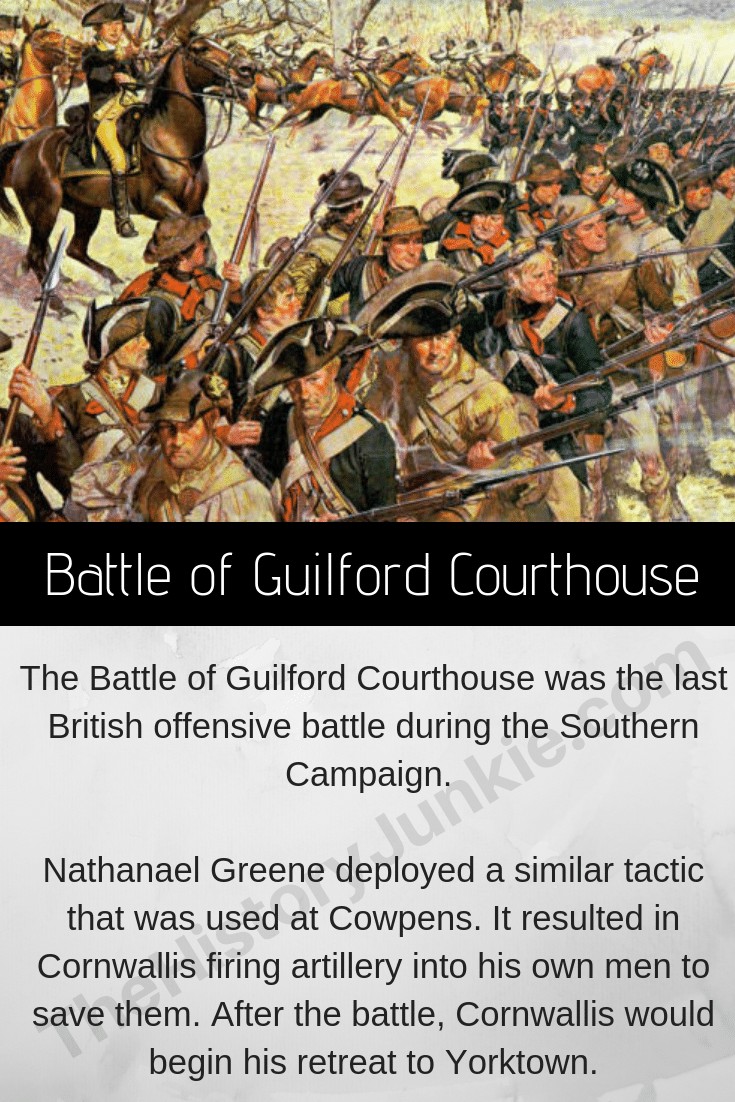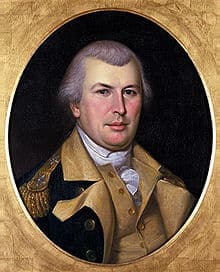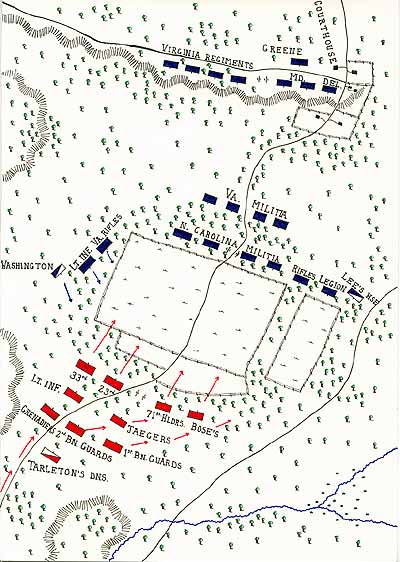The Battle of Cowpens took place in South Carolina colony and was a turning point in the Southern Campaign. Nathanael Greene borrowed Morgans use of militia in the Battle of Guilford Courthouse which resulted in a British massacre.

Although the British took the field their casualties were so high that it was impossible for Cornwallis to continue. He began his retreat which would result in him being cornered in Yorktown. Cornwallis was once again bested by Greene.
After General Daniel Morgan shocked the British with a quick and lethal defeat at the Battle of Cowpens he turned his army northward away from General Charles Cornwallis who was in hot pursuit of him.
He moved into the center of the North Carolina Colony and along with General William Davidson harassed the British at every turn.

They were successful at slowing the British, however, General Davidson and many of his men were killed while trying to obstruct Cowan's Ford.
Although they were killed General Davidson's action slowed the British down immensely.
North of the river, Nathanael Greene reorganized his army and gave them some time to rest.
With his reinforcements from Virginia not arriving and many of his own enlistments up he knew he had to pick a fight with Cornwallis.
However, many of his men had already left and they had left him with only 1,500 men to fight some of the most experienced troops in the British army.
Intelligence arrived and informed Greene that Cornwallis was retiring south. In response, Greene sent small detachments to harass the enemy on their way.
This guerrilla-style fighting was effective and would frustrate and bleed Cornwallis's forces. Greene was encouraged to re-cross the Dan River when 600 militiamen from Virginia showed up.
Once across the river, he was encouraged even more when volunteers from North Carolina flocked to his army.
He went from 1,500 men to about 4,400 men. Now all that was left was to find the best site and terrain to engage the enemy and wait.
British Perspective

General Cornwallis was obsessed with finding Greene. When he believed he was slowed by wagons and artillery he opted to burn them to speed up his chase.
However, his men were becoming exhausted and this chase was becoming time-consuming.
Reminiscent of Green and Cornwallis' chase before the Battle of Trenton, Cornwallis chased Green towards the Dan River. He believed that if he could reach him in time that he could end the war in the south for good.
However, Greene tricked him and Cornwallis fell into his trap. Greene had sent a decoy force under Otto Williams to keep Cornwallis occupied.
While after the decoy force Banastre Tarleton, fresh off the Cowpens debacle, fought a few skirmishes with Williams' rear guard that would only bleed and frustrate Cornwallis' forces.
Williams was leading Cornwallis in the wrong direction while Greene and his men were marching east and crossing the lower fords.
When the British General learned of Greene's trickery he was enraged and retreated to Hillsborough where he established a headquarters and allowed his men to rest.
This also gave him the opportunity to recruit some more loyalists for battle.
In early March, Cornwallis was informed that Greene had recrossed the river and was back in North Carolina. Cornwallis once again aggressively pursued him.
For 10 days the two maneuvered their army and Greene was able to always stay one step ahead of him.
On March 14, Cornwallis learned that Greene was camped merely 12 miles away at Guilford Courthouse. He awoke his men and aggressively marched his exhausted army toward Greene who was finally ready to fight.
The Fighting
Greene's army was primarily made up of militia and it was not until the Battle of Cowpens when Daniel Morgan routed Banastre Tarleton that the commanders in the American army figured out how to use the militia to their advantage.
Along with the Cowpens' influence came a great knowledge of the terrain. Greene had arrived at the Battle of Guilford Courthouse battlefield before Cornwallis and was ready for a showdown.

He positioned his army in a way to take advantage of the terrain. He established his defensive position in-depth in three successive lines of infantry supported by cavalry and artillery.
Greene's militia under Brigadier General John Butler and Colonel Thomas Eaton were placed in the front line along the edge behind a split rail fence. In front of them was a field that would allow deadly accuracy on the opposing British.
Two pieces of small artillery were placed on the road in the middle of the line. Their flanks were covered by veteran infantry and cavalry. The second line stood about 350 yards behind the first. 1,200 Virginia militiamen with a mixture of veteran Continental soldiers made up this line.
The third line was made up of Greene's best troops. There were 1,400 American Regulars from Virginia, Delaware, and Maryland on the west side of the road.
Cornwallis pressed forward with his experienced, yet exhausted troops. About four miles west of the Battle of Guilford Courthouse battlefield, some dismounted American cavalry began to harass the British.
Cornwallis began to deploy his tired and hungry men without rest or food. He brought up his artillery to the front of the line to counter the American fire and proceeded to divide his army into two wings.
Some of the most experienced troops in the British army moved forward and met the Americans head-on. To their surprise, the militia was different from the militia they met in Camden in that they did not fold in the face of British regulars.
Instead, they raised their muskets and delivered one of the deadliest volleys of the entire war. The British were confounded, but the commanders steadied the men and ready for another volley, however, the first line of Greene's men melted away and the second line of his army awaited
The British moved forward with utmost discipline. While moving forward they met small pockets of opposition that would be deadly and confuse the British even more. Even though the Americans had launched a devastating defense, the British continued to move forward and proceeded to engage the second line made up of Virginia militia.
This fight was even harder than the first. The British were fighting uphill and their volleys were ineffective while the Americans continued to rain down deadly volleys. Eventually, Cornwallis' left wing was able to force the American right to retreat.
The second line did as the first line did and faded away revealing the third line.
The third line was some of the hardest fighting in the entire war. Here the British met Greene's best troops at the Battle of Guilford Courthouse. The Americans launched a quick attack on Cornwallis' left which was repelled by the British.
On the British right, they launched a bayonet charge which overran the Americans and captured two pieces of artillery. However, the Continental Army pushed back and was able to seal the breach in the line with hard-fought hand-to-hand combat.
This left Cornwallis' army in disarray and forced him to do something that showed his desperation.
Believing that his army was close to being swept off the field he opened fire with his artillery on both the British and Americans which would break up the collision. He then ordered Banastre Tarleton to attack.
Greene had already begun an orderly retreat while Tarleton swept the remaining Continental Patriots off the field. The Battle of Guilford Courthouse was over.
Outcome
Since the British took the field at the Battle of Guilford Courthouse they were officially the victors, but it was a costly victory.
Cornwallis was unable to have a decisive win against Greene and the cost of the battle would force him to retreat towards Virginia and eventually end up at Yorktown.
Any more victories such as Guilford for the British would have resulted in the annihilation of the British Southern Army.
The Americans, however, accomplished exactly what they wanted to do and even though they abandoned the field they knew they had dealt the British a harsh blow. Greene would continue to harass the British on their retreat back to Yorktown.
Greene now controlled all of North Carolina except for a small corner. Amazingly Greene had taken a crushed army after the Battle of Camden and made it into a fierce fighting force after the Battle of Guilford Courthouse.
